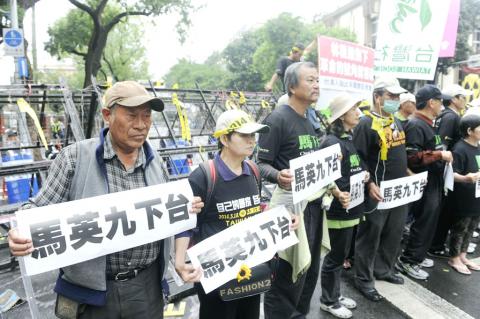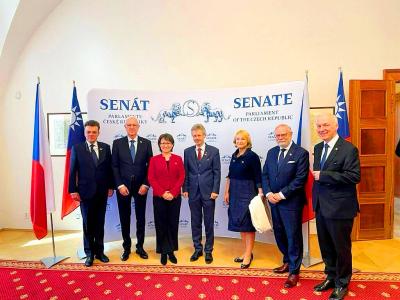About 100 academics yesterday staged a silent march from Ketagalan Boulevard in front of the Presidential Office Building to Gikong Presbyterian Church, where former Democratic Progressive Party chairman Lin I-hsiung (林義雄) has been on a hunger strike since Tuesday, to urge the government to give up nuclear energy.
“Nuclear power is the most negative product of capitalism and imperialism, it’s a disaster for the disadvantaged,” said Cheng Fei-wen (鄭斐文), an associate professor of sociology at Tung Hai University.
“When nuclear disaster occurs, it is the poor, the aged and children who will suffer the most. Even today, the Tao people on Orchid Island still suffer from nuclear waste storage,” he added.

Photo: Chien Jung-fong, Taipei Times
National Chung Cheng University professor Chen Ruey-lin (陳瑞麟) said Taiwan was located in the so-called “Ring of Fire,” where frequent earthquakes and volcanic eruptions occur in the basin of the Pacific Ocean.
“I don’t think Taiwan is qualified to use nuclear energy,” he added.
Nuclear disasters have occurred in many countries with advanced nuclear technology, such as the former Soviet Union, the US and Japan, Chen said.

Photo: Chen Chih-chu, Taipei Times
“It’s difficult for the government to convince us that we can do better than those countries,” the professor added.
“Nuclear disasters take different forms each time they happen. We cannot foresee them coming and there’s no way we can implement a preventive measure that would be 100 percent safe,” Chen said. “This is why I think we shouldn’t take the risk at all.”
Taiwan Association of University Professors president Lu Chung-chin (呂忠津), who teaches electrical engineering at National Tsing Hua University, said the government should not continue to threaten the public by saying that there may be a power shortage without the Fourth Nuclear Power Plant.
“It would be better if the government could use this critical time to develop a green energy system for our future,” he said.
The group marched in silence to the church after tying yellow ribbons with the slogan: “Stop the Fourth Nuclear Power Plant; return the power to the people” on police barricades that barred them from getting close to the Presidential Office Building.
Separately yesterday, another group of antinuclear activists urged the government to respond positively to Lin’s demands, otherwise, Taiwan Society North chairman Chang Yeh-shen (張葉森) said, “the moment that Lin collapses will be the moment the revolution starts.”
Meanwhile, in an effort to force legislators to take a stance, Alliance of Referendum for Taiwan convener Tsay Ting-kuei (蔡丁貴) yesterday afternoon called on supporters to blockade every exit of the Legislative Yuan in a bid to prevent legislators and governmental vehicles from leaving the premises.
The action caused clashes between security and the protesters.
In the midst of the scuffles, Chinese Nationalist Party (KMT) Legislator Alex Tsai (蔡正元) was filmed ordering his chauffeur to drive off the premises, while two protesters were clinging to the hood of his car.
Video footage was uploaded by an individual who was severely critical of Tsai, labeling his order to drive away to be as heinous as an act of hit and run.
Tsai responded on Facebook by branding the gathered groups “rioters” who used clubs to crack car windshields.
The “rioters” climbed on to the hood of his car and initiated violence by hammering the vehicle, he added.
Additional reporting by Tseng Wei-chen

The Mainland Affairs Council (MAC) today condemned the Chinese Communist Party (CCP) after the Czech officials confirmed that Chinese agents had surveilled Vice President Hsiao Bi-khim (蕭美琴) during her visit to Prague in March last year. Czech Military Intelligence director Petr Bartovsky yesterday said that Chinese operatives had attempted to create the conditions to carry out a demonstrative incident involving Hsiao, going as far as to plan a collision with her car. Hsiao was vice president-elect at the time. The MAC said that it has requested an explanation and demanded a public apology from Beijing. The CCP has repeatedly ignored the desires

Many Chinese spouses required to submit proof of having renounced their Chinese household registration have either completed the process or provided affidavits ahead of the June 30 deadline, the Mainland Affairs Council (MAC) said on Thursday. Of the 12,146 people required to submit the proof, 5,534 had done so as of Wednesday, MAC deputy head and spokesperson Liang Wen-chieh (梁文傑) said. Another 2,572 people who met conditions for exemption or deferral from submitting proof of deregistration — such as those with serious illnesses or injuries — have submitted affidavits instead, he said. “As long as individuals are willing to cooperate with the legal

The Ma-anshan Nuclear Power Plant’s license has expired and it cannot simply be restarted, the Executive Yuan said today, ahead of national debates on the nuclear power referendum. The No. 2 reactor at the Ma-anshan Nuclear Power Plant in Pingtung County was disconnected from the nation’s power grid and completely shut down on May 17, the day its license expired. The government would prioritize people’s safety and conduct necessary evaluations and checks if there is a need to extend the service life of the reactor, Executive Yuan spokeswoman Michelle Lee (李慧芝) told a news conference. Lee said that the referendum would read: “Do

Taiwan's Vice President Hsiao Bi-khim (蕭美琴) said Saturday that she would not be intimidated by the Chinese Communist Party (CCP), following reports that Chinese agents planned to ram her car during a visit to the Czech Republic last year. "I had a great visit to Prague & thank the Czech authorities for their hospitality & ensuring my safety," Hsiao said on social media platform X. "The CCP's unlawful activities will NOT intimidate me from voicing Taiwan's interests in the international community," she wrote. Hsiao visited the Czech Republic on March 18 last year as vice president-elect and met with Czech Senate leadership, including